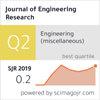A novel image compression method using wavelet coefficients and Huffman coding
IF 0.9
4区 工程技术
Q3 ENGINEERING, MULTIDISCIPLINARY
引用次数: 0
Abstract
Compressing medical images to reduce their size while maintaining their clinical and diagnostic information is crucial. Because medical images can be large and demand a lot of storage and transmission capacity, effective compression methods aid medical institutions in better storing and transmitting medical images, reducing costs, speeding up data transfer, and simplifying managing image databases. However, it is essential to note that image compression in medical imaging can also introduce drawbacks, such as loss of information and poor output image quality. Therefore, a suitable compression algorithm and parameter must be chosen to balance file size and visual fidelity. This paper suggests an effective image compression method employing the Discrete Wavelet Transform (DWT), followed by a reduction operation and Huffman coding to produce a mere lossless encoding to transmit the images over a channel. The extracted DWT coefficients are mapped to the nearest integral value. All four sub-bands of DWT are joined, and then a window of 3 × 3 is selected for reduction operation by choosing the origin as the pivot element. The Huffman coding algorithm is used to compress the processed image. The pivot origin element is used in the reversible reduction while uncompressing the image. When sending compressed data across an unreliable route, the window size and pivot element selection keep the compressed data secure. Standard measures such as bits per pixel (BPP) and compression ratio (CR) are used to assess the suggested approach. The efficiency of the suggested course of action is supported by the research's findings, which use a peak signal-to-noise ratio (PSNR) of 54.66 dB.
一种基于小波系数和霍夫曼编码的图像压缩方法
压缩医学图像以减小其大小,同时保持其临床和诊断信息是至关重要的。由于医学图像规模较大,需要大量的存储和传输容量,有效的压缩方法可以帮助医疗机构更好地存储和传输医学图像,降低成本,加快数据传输速度,简化图像数据库的管理。然而,必须注意的是,医学成像中的图像压缩也会引入缺点,例如信息丢失和输出图像质量差。因此,必须选择合适的压缩算法和参数来平衡文件大小和视觉保真度。本文提出了一种有效的图像压缩方法,采用离散小波变换(DWT),然后进行约简操作和霍夫曼编码,以产生纯粹的无损编码,通过信道传输图像。提取的DWT系数被映射到最接近的整数值。将DWT的四个子带全部连接起来,然后选择一个3 × 3的窗口进行约简操作,选择原点作为主元。采用霍夫曼编码算法对处理后的图像进行压缩。在解压缩图像时,在可逆还原中使用枢轴原点元素。当通过不可靠的路由发送压缩数据时,窗口大小和枢轴元素选择可以保证压缩数据的安全。标准措施,如比特每像素(BPP)和压缩比(CR)被用来评估建议的方法。建议的行动方案的效率得到了研究结果的支持,该研究使用54.66 dB的峰值信噪比(PSNR)。
本文章由计算机程序翻译,如有差异,请以英文原文为准。
求助全文
约1分钟内获得全文
求助全文
来源期刊

Journal of Engineering Research
ENGINEERING, MULTIDISCIPLINARY-
CiteScore
1.60
自引率
10.00%
发文量
181
审稿时长
20 weeks
期刊介绍:
Journal of Engineering Research (JER) is a international, peer reviewed journal which publishes full length original research papers, reviews, case studies related to all areas of Engineering such as: Civil, Mechanical, Industrial, Electrical, Computer, Chemical, Petroleum, Aerospace, Architectural, Biomedical, Coastal, Environmental, Marine & Ocean, Metallurgical & Materials, software, Surveying, Systems and Manufacturing Engineering. In particular, JER focuses on innovative approaches and methods that contribute to solving the environmental and manufacturing problems, which exist primarily in the Arabian Gulf region and the Middle East countries. Kuwait University used to publish the Journal "Kuwait Journal of Science and Engineering" (ISSN: 1024-8684), which included Science and Engineering articles since 1974. In 2011 the decision was taken to split KJSE into two independent Journals - "Journal of Engineering Research "(JER) and "Kuwait Journal of Science" (KJS).
 求助内容:
求助内容: 应助结果提醒方式:
应助结果提醒方式:


